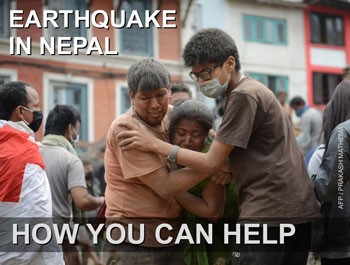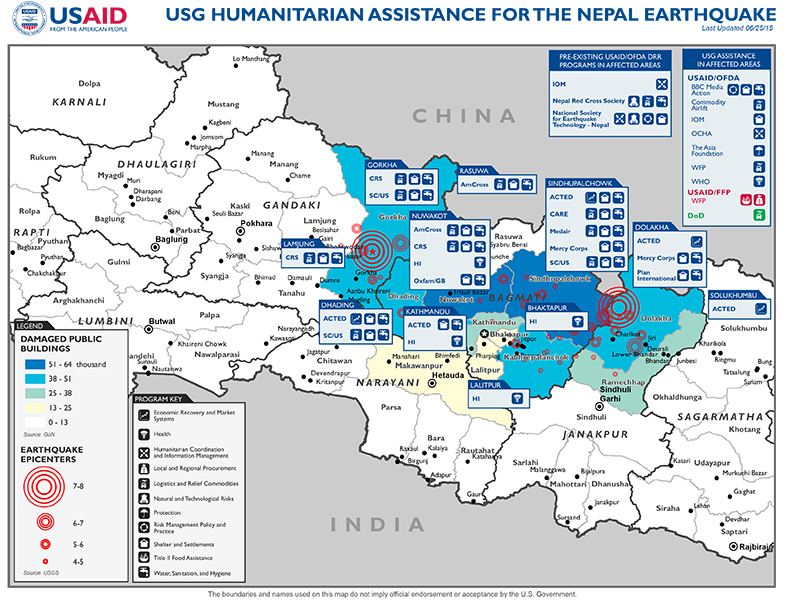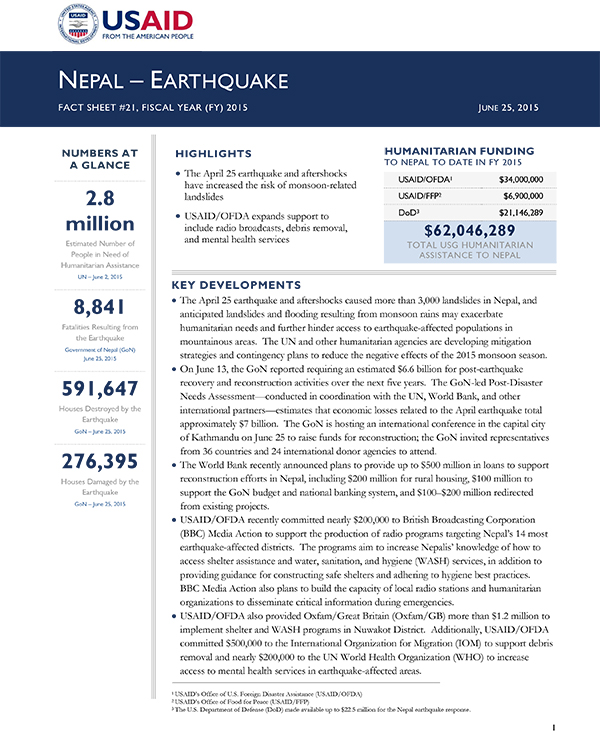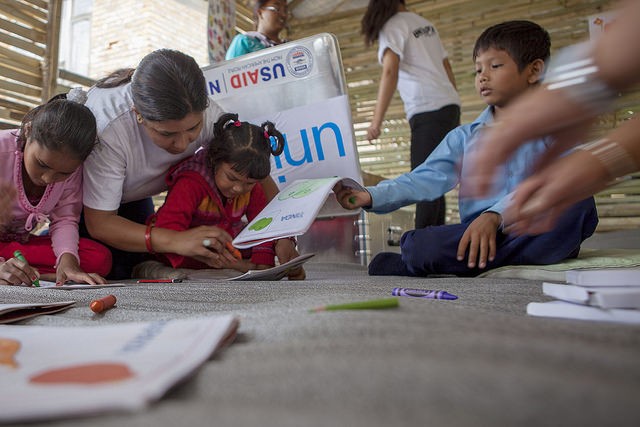June 25, 2015
Highlights
The April 25 earthquake and aftershocks have increased the risk of monsoon-related landslides.
USAID/OFDA expands support to include radio broadcasts, debris removal, and mental health services.
Key Developments
The April 25 earthquake and aftershocks caused more than 3,000 landslides in Nepal, and anticipated landslides and flooding resulting from monsoon rains may exacerbate humanitarian needs and further hinder access to earthquake-affected populations in mountainous areas. The UN and other humanitarian agencies are developing mitigation strategies and contingency plans to reduce the negative effects of the 2015 monsoon season.
Nepal Map - 06-25-2015 ![]() (pdf - 1018k)
(pdf - 1018k)
Numbers At A Glance
2.8 million
8,841
591,647
276,395
Humanitarian Funding:
To Nepal To Date In FY2015:
| USAID/OFDA | $34,000,000 |
| USAID/FFP | $6,900,000 |
| DoD | $21,146,289 |
| TOTAL | $62,046,289 |
Nepal Earthquake Fact Sheet #21 - 06-25-2015 ![]() (pdf - 215k)
(pdf - 215k)
On June 13, the GoN reported requiring an estimated $6.6 billion for post-earthquake recovery and reconstruction activities over the next five years. The GoN-led Post-Disaster Needs Assessment—conducted in coordination with the UN, World Bank, and other international partners—estimates that economic losses related to the April earthquake total approximately $7 billion. The GoN is hosting an international conference in the capital city of Kathmandu on June 25 to raise funds for reconstruction; the GoN invited representatives from 36 countries and 24 international donor agencies to attend.
The World Bank recently announced plans to provide up to $500 million in loans to support reconstruction efforts in Nepal, including $200 million for rural housing, $100 million to support the GoN budget and national banking system, and $100–$200 million redirected from existing projects.
USAID/OFDA recently committed nearly $200,000 to British Broadcasting Corporation (BBC) Media Action to support the production of radio programs targeting Nepal’s 14 most earthquake-affected districts. The programs aim to increase Nepalis’ knowledge of how to access shelter assistance and water, sanitation, and hygiene (WASH) services, in addition to providing guidance for constructing safe shelters and adhering to hygiene best practices. BBC Media Action also plans to build the capacity of local radio stations and humanitarian organizations to disseminate critical information during emergencies.
USAID/OFDA also provided Oxfam/Great Britain (Oxfam/GB) more than $1.2 million to implement shelter and WASH programs in Nuwakot District. Additionally, USAID/OFDA committed $500,000 to the International Organization for Migration (IOM) to support debris removal and nearly $200,000 to the UN World Health Organization (WHO) to increase access to mental health services in earthquake-affected areas.
HUMANITARIAN ASSESSMENTS
Between June 14 and 16, USAID/OFDA and USAID/Nepal staff traveled to Nuwakot and Rasuwa districts to meet with local communities and observe USAID/OFDA-supported response activities. Residents identified shelter assistance, safe drinking water, and improved sanitation facilities as priority needs, while USAID/OFDA staff observed that the earthquake had less impact on food security and livelihoods in visited areas.
In coordination with local authorities, USAID/OFDA partner the American Red Cross (AmCross) continues to distribute emergency relief commodities and support response efforts in Nuwakot and Rasuwa. The distributions, which include blankets, tarpaulins, kitchen sets, and hygiene and tool kits, are community-driven. Local populations assist in determining beneficiary lists, prioritizing female-led households and those with recent deaths, disabilities, or elderly family members. USAID/OFDA is also supporting AmCross to train 85 community mobilizers to teach hygiene promotion and emergency shelter construction techniques to community members.
USAID/OFDA recently provided Oxfam/GB more than $1.2 million to provide shelter materials and increase access to WASH facilities for approximately 2,650 households—13,000 people—in two hard-to-reach village development committees in Nuwakot. Oxfam/GB plans to repair water system infrastructure to increase community access to safe drinking water and distribute tarpaulins and rope to families whose houses were damaged or destroyed to facilitate the construction of emergency shelters.
In Rasuwa, USAID/OFDA staff observed Save the Children/U.S. (SC/US) distributing emergency relief kits—including basic household goods, hygiene supplies, and shelter materials—to earthquake-affected communities. SC/US is also establishing contingency emergency relief commodity stocks in strategic locations across Rasuwa in preparation for limited road access during the monsoon season. SC/US is responding to the humanitarian needs in Rasuwa with funding from other donors; however, USAID/OFDA is supporting SC/US to implement similar activities in Dhading, Gorkha, and Sindhupalchowk districts.
HUMANITARIAN ACCESS AND LOGISTICS
Annual monsoon rains in Nepal regularly cause floods and landslides, and relief agencies expect the 2015 monsoon season—which began in eastern Nepal in recent weeks—to exacerbate humanitarian needs in earthquake-affected areas. In previous years, the effects of monsoon rains have resulted in loss of life and livelihoods, as well as significant damage to infrastructure, throughout Nepal.
According to the International Centre for Integrated Mountain Development, areas of Nepal affected by the April 25 earthquake and aftershocks have experienced more than 3,000 landslides since the initial earthquake—more than the total number of landslides reported in the previous five years. The landslides have destabilized slopes in earthquake-affected areas, increasing the risk of additional landslides during monsoon season. Relief agencies also remain concerned about flash floods, which may result from heavy rains or the bursting of artificial dams created by landslides. In addition to threatening life and property, monsoon-related floods and landslides may reduce access to earthquake-affected populations due to impassible roads, blocked footpaths, and inclement weather that hinders air transport.
The Nepal Earthquake Assessment Unit—comprising UN agencies, non-governmental organizations (NGOs), and international donors—released a report on June 23 that outlined monsoon season hazards and provided short-term mitigation strategies for community members and humanitarian organizations. The report emphasized the need for early warning systems and continuous monitoring, rapid response coordination, guidance for choosing temporary displacement sites, contingency planning, and messaging for communities at risk. The report also noted the need for long-term solutions to mitigate the annual risk of landslides and flash floods.
On June 10, USAID/OFDA staff participated in an emergency response planning (ERP) session hosted by the UN Office for the Coordination of Humanitarian Affairs (OCHA) to improve international response coordination and contingency plans in case significant flooding occurs in Nepal during the 2015 monsoon season. ERP participants, in consultation with the GoN and Humanitarian Country Team, identified 18 priority districts in Nepal’s Terai region—outside the earthquakeaffected areas—that are at risk for flooding in the coming months. The UN also designated lead NGOs for each priority district to coordinate international support for GoN-led flood response activities and is preparing 30-day flood response contingency plans that focus on five priority sectors—health, protection, shelter, WASH, and emergency food assistance.
Air transport remains the only viable option for reaching many earthquake-affected populations in Nepal, and the UN Humanitarian Air Service (UNHAS) continues to offer daily flights for both cargo and passengers, according to the Logistics Cluster—the coordinating body for humanitarian logistics activities, comprising UN agencies, NGOs, and other stakeholders. As of June 23, UNHAS reported assisting 91 organizations by transporting more than 1,600 passengers and approximately 840 metric tons (MT) of cargo to 117 locations since operations began on April 28. UNHAS has indicated plans to increase its fleet to meet the growing demand for air transport; the fleet currently comprises two passenger helicopters and four helicopters for cargo transport.
The Logistics Cluster also continues to transport relief items by road and reported dispatching more than 1,500 truckloads of supplies—carrying approximately 8,700 MT of cargo—from logistics hubs in Gorkha, Kathmandu, and Sindhupalchowk as of June 20. Additionally, the cluster’s efforts to establish a supply chain using porters and mountaineers to reach areas inaccessible by road or air remain ongoing. Cluster partners recently dispatched the first porters carrying approximately 115 MT of food and nearly 4 MT of relief supplies to Dolakha and Gorkha districts.
On June 22, USAID/OFDA staff met with NGO partners to discuss ongoing earthquake response activities, as well as successes and challenges over the previous two months. Partners reported reaching remote earthquake-affected populations with emergency assistance, including relief commodities, emergency shelter materials, and hygiene kits. NGOs noted that logistical challenges are limiting access to some remote communities and that national and sub-national coordination and supply chain challenges have negatively affected response efforts. Partners indicated that shelter and WASH assistance remain key response priorities, and continued protection and livelihoods assistance is essential throughout the transition to recovery and reconstruction activities.
In coordination with the GoN, USAID/OFDA continues to support UN and NGO partners to develop contingency plans and pre-position emergency relief commodities for earthquake-affected populations, as well as populations in areas at risk of flooding. To date, USAID/OFDA has provided more than $9.8 million to strengthen logistical capacity in Nepal and provide emergency relief items to earthquake-affected households.
DISPLACEMENT AND SHELTER
Between May 21 and June 8, IOM assessed 145 displacement sites across 15 districts to complete a second round of the Displacement Tracking Matrix (DTM). As of June 8, an estimated 118,000 displaced people were sheltering in approximately 410 sites, according to the DTM. OCHA reports that people continue to arrive at the current sites, and monsoon season will likely further increase the number of displaced people seeking shelter.
IOM is prioritizing displacement sites with more than 50 households for response efforts, and the DTM identified 77 priority sites that host a total of more than 49,000 people. Nearly 60 percent of the priority sites are privately owned, and displaced persons have reported additional shelter support as the most critical need. IOM is currently examining environmental hazards and social challenges at the priority displacement sites and has identified a need to increase site management capacity. The Shelter Cluster plans to conduct site management training for local authorities and key humanitarian partners in the coming weeks.
The April 25 earthquake and aftershocks have damaged or destroyed more than 868,000 houses, according to the GoN. During the DTM assessment, 68 percent of displaced people interviewed cited damage to their houses as the biggest obstacle to returning home, while 11 percent mentioned a lack of personal security, and 8 percent noted infrastructure damage. IOM reports that many people who rented accommodation prior to the earthquake now face a shortage of rental properties and higher prices.
Demolishing collapsed and damaged structures remains essential to rebuilding houses and other buildings in earthquakeaffected areas of Nepal. On June 14, the GoN declared Kathmandu Valley—comprising Bhaktapur, Kathmandu, and Lalitpur districts—a crisis zone for a one-year period to allow the GoN to accelerate the demolition of buildings.
USAID/OFDA recently committed an additional $500,000 to IOM to support its debris removal program in earthquakeaffected areas of Nepal. The cash-for-work program provides livelihoods opportunities while also increasing community safety and enabling the reconstruction of houses and infrastructure.
HEALTH
Following the April 25 earthquake, the health sector response in Nepal focused primarily on trauma case management and was heavily supported by foreign medical teams. As of June 19, the Health Cluster reported that the focus has transitioned to resuming regular health services—provided primarily by Nepali health care workers in tents and other temporary structures—and rehabilitating damaged health facilities.
As of June 9, USAID/OFDA partner Handicap International (HI) reported supporting medical services for more than 1,150 earthquake-affected people across seven districts—Bhaktapur, Kathmandu, Kavrepalanchowk, Lalitpur, Nuwakot, Rasuwa, and Sindhupalchowk.
USAID/OFDA recently provided WHO nearly $200,000 to increase access to mental health services and coordinate mental health and psychosocial support services in earthquake-affected areas. WHO plans to establish a network of trained physicians to provide mental health services in the 14 most-affected districts and collaborate with the appropriate health and protection sub-clusters to ensure a coordinated response. USAID/OFDA previously provided WHO $500,000 to strengthen disease surveillance in Nepal.
INTERNATIONAL ASSISTANCE
As of June 25, the USG had provided more than $62 million for earthquake response efforts in Nepal, while other international donors had provided nearly $327 million. Of the total international humanitarian assistance, approximately $159 million has supported the current UN flash appeal—38 percent of the $422 million requested.
CONTEXT
On April 25, a magnitude 7.8 earthquake struck central Nepal’s Gorkha District, approximately 77 kilometers (km) northwest of Kathmandu, at a shallow depth of approximately 15 km, according to the U.S. Geological Survey (USGS).
The USG immediately issued a disaster declaration for Nepal due to the effects of the earthquake. Within hours of the seismic event, USAID/OFDA activated a Response Management Team (RMT) in Washington, D.C., and deployed a Disaster Assistance Response Team (DART)—including urban search-and-rescue (USAR) specialists—to Nepal.
On May 12, a magnitude 7.3 aftershock struck Nepal’s Dolakha District, approximately 76 km northeast of Kathmandu, according to USGS. The aftershock caused further casualties and damage in areas affected by the April 25 earthquake.
For nearly two decades, USAID/OFDA has supported disaster risk reduction (DRR) efforts in Nepal, including throughout Kathmandu Valley. USAID/OFDA funding has enabled partners to identify, prepare, and preserve more than 80 open spaces in Kathmandu Valley for humanitarian purposes; pre-position critical emergency relief supplies; and strengthen earthquake response capacity at the local and national levels in collaboration with the GoN, nongovernmental organizations, private companies, and local communities. More information on USAID/OFDA’s DRR programs in Nepal and throughout South Asia is available at www.usaid.gov/what-we-do/working-crises-andconflict/disaster-risk-reduct....
PUBLIC DONATION INFORMATION
The most effective way people can assist relief efforts is by making cash contributions to humanitarian organizations that are conducting relief operations. A list of humanitarian organizations that are accepting cash donations for disaster responses around the world can be found at www.interaction.org.
USAID encourages cash donations because they allow aid professionals to procure the exact items needed (often in the affected region); reduce the burden on scarce resources (such as transportation routes, staff time, and warehouse space); can be transferred very quickly and without transportation costs; support the economy of the disaster-stricken region; and ensure culturally, dietary, and environmentally appropriate assistance.
More information can be found at:
- The Center for International Disaster Information: www.cidi.org or +1.202.821.1999.
-
Information on relief activities of the humanitarian community can be found at www.reliefweb.int.











Comment
Make a general inquiry or suggest an improvement.